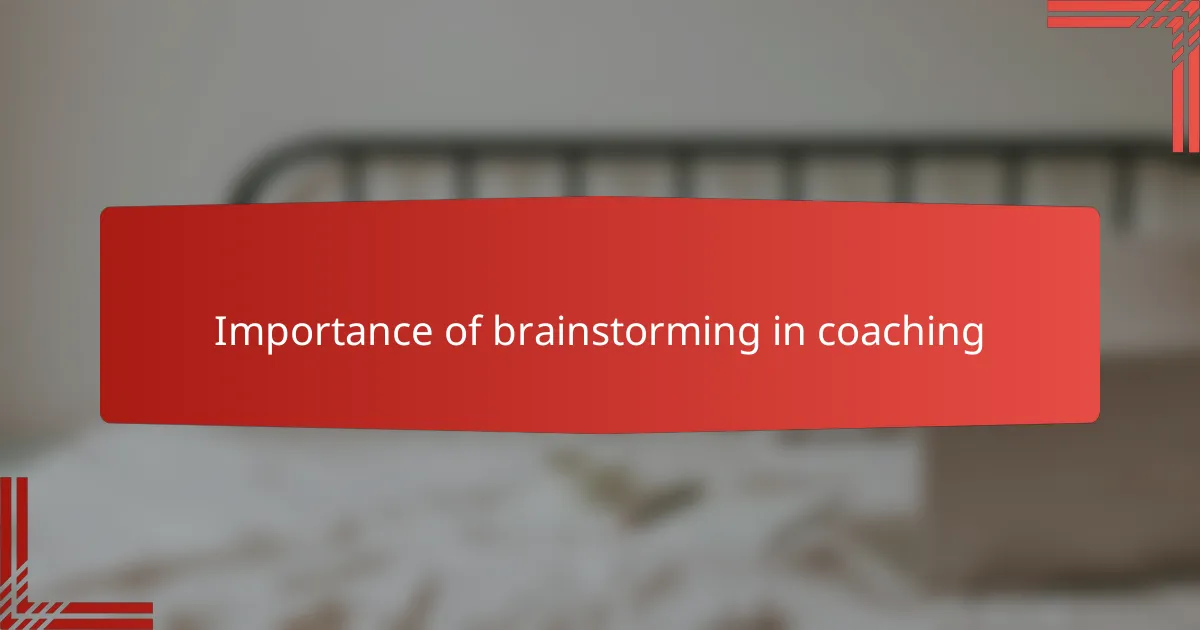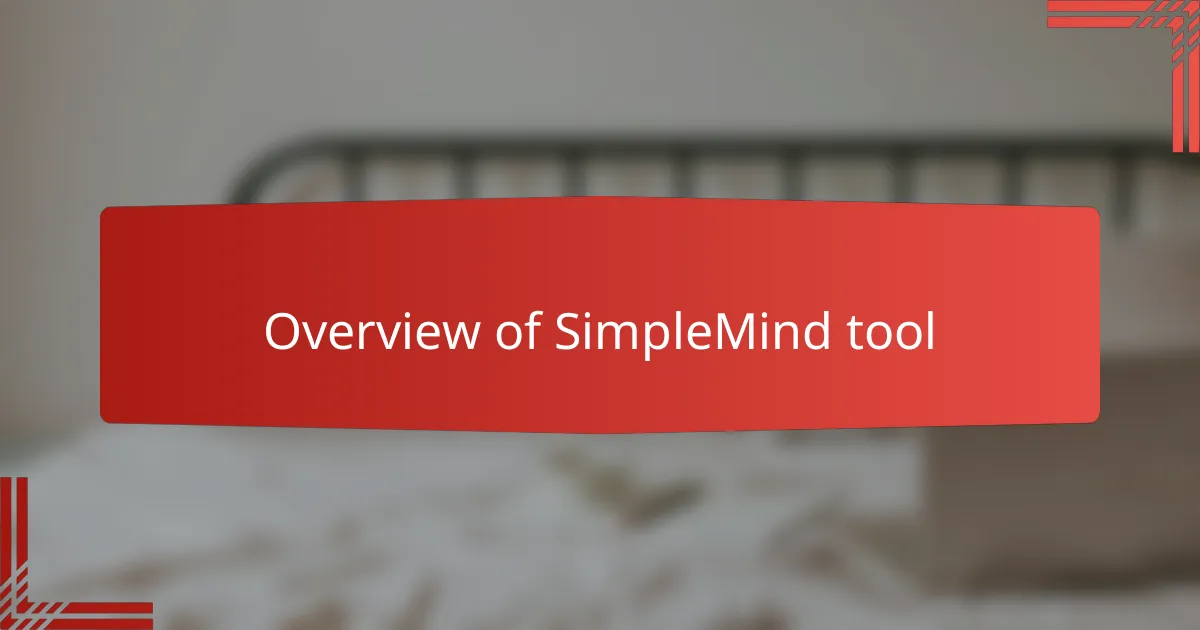Key takeaways
- Community life coaching emphasizes collective well-being, fostering connections and supportive networks for personal and group growth.
- Brainstorming is a transformative part of coaching, enhancing creativity and uncovering new insights through collaborative idea sharing.
- SimpleMind is an effective mind-mapping tool that organizes thoughts visually, improving clarity and facilitating productive brainstorming sessions.
- Regularly refining mind maps during brainstorming enhances focus and creates actionable plans, making the process more engaging and effective.

Understanding community life coaching
Community life coaching, in my experience, is more than just guidance; it’s a shared journey towards growth and connection. Have you ever felt stuck in a routine that isolates you from those around you? That’s where community coaching steps in, helping us rediscover our place within a group and fostering meaningful relationships.
What strikes me most about this approach is its emphasis on collective well-being rather than just individual success. It makes me think about times when my own progress felt shallow because I wasn’t engaging with others who shared similar goals. Community life coaching challenges that by building supportive networks that lift everyone involved.
Isn’t it fascinating how personal growth accelerates when we feel connected and supported? From what I’ve seen, community life coaching taps into this by nurturing empathy, accountability, and collaboration—qualities that transform not only individuals but entire groups.

Importance of brainstorming in coaching
Brainstorming in coaching is more than just throwing ideas around—it’s a powerful way to unlock hidden potential. I remember sessions where a simple idea sparked during brainstorming completely changed the course for a client; it’s like lighting a fire that fuels motivation and clarity.
Have you ever noticed how the energy shifts when everyone starts contributing freely? That collaborative spirit often reveals insights that wouldn’t surface in a one-on-one conversation. To me, brainstorming creates a safe space where creativity thrives, encouraging risk-taking and fresh perspectives.
It’s this dynamic exchange that makes coaching truly transformative. When ideas bounce back and forth, coaches and clients alike discover new pathways they hadn’t considered before. Reflecting on my own experiences, I see brainstorming as the heartbeat of effective coaching, driving meaningful progress.

Overview of SimpleMind tool
SimpleMind is a mind-mapping tool that I’ve found incredibly helpful for organizing thoughts during brainstorming sessions. What I appreciate most is its intuitive design—it doesn’t get in the way of the creative flow but actually enhances it by allowing ideas to branch out visually. Have you ever tried mapping your thoughts only to feel overwhelmed by clutter? SimpleMind helps prevent that by keeping everything neat and accessible.
One time, while coaching a community group, I encouraged everyone to use SimpleMind for a joint brainstorming exercise. Watching the map grow in real time was exciting; it felt like the ideas were literally connecting us. The visual layout made it easier for people to see patterns and relationships, which sparked even deeper conversations.
I also like that SimpleMind is flexible—it works on different devices and syncs smoothly, which means I can capture inspiration whenever it strikes. From my experience, having such a dependable tool removes a lot of the stress around brainstorming, letting creativity take center stage.

How SimpleMind supports brainstorming
When I use SimpleMind for brainstorming, I notice how effortlessly my scattered ideas start to come together. Have you ever tried to organize thoughts only to get lost in a tangle of notes? SimpleMind’s visual mapping turns that mess into a clear, evolving picture, which really helps me focus and stay motivated.
What stands out to me is how SimpleMind encourages free-flowing creativity without chaos. As branches grow and connect, I feel like I’m uncovering new insights that might have stayed hidden in a linear list. It’s like watching my mind come to life right on the screen, and that energy is contagious during group sessions.
Sometimes, when ideas get stuck, I find that the drag-and-drop feature sparks a breakthrough—moving just one node can reshape the whole map and shift my thinking. Isn’t it amazing how a simple interaction can reignite fresh perspectives? SimpleMind supports brainstorming by turning abstract ideas into a dynamic, interactive experience that truly feels alive.

My experience using SimpleMind
Using SimpleMind for the first time felt like discovering a new way to think out loud. Have you ever stared at a blank page, unsure where to start? For me, the visual layout made that overwhelming feeling disappear almost instantly.
During one particularly challenging coaching session, I watched as participants’ ideas blossomed right before my eyes on SimpleMind. It was more than just a tool—it became a shared canvas where everyone’s thoughts connected and grew, creating a sense of unity I didn’t expect.
What I find most rewarding is how SimpleMind adapts to my flow; sometimes I start with a broad concept, and as ideas emerge, the map reshapes with ease. That flexibility keeps me engaged and makes brainstorming feel less like a task and more like an inspired conversation.

Tips for effective brainstorming with SimpleMind
When I brainstorm with SimpleMind, one tip I always follow is to start with one clear central idea and let the branches flow naturally from there. Have you ever tried to juggle too many thoughts at once, only to end up overwhelmed? Focusing on a single core concept helps me maintain clarity and prevents the map from becoming a confusing tangle.
Another thing I’ve learned is to embrace the flexibility of SimpleMind’s drag-and-drop feature. Moving ideas around can feel like rearranging puzzle pieces, sparking new connections I hadn’t noticed before. Sometimes, just shifting one branch leads to a breakthrough that changes the entire direction of my thinking. Isn’t it amazing how small adjustments can open up fresh perspectives?
Lastly, I recommend regularly reviewing and refining your mind map as ideas evolve. It’s easy to get caught up in capturing every single thought, but stepping back to reorganize makes the brainstorming session more productive. In my experience, this practice turns a chaotic flow into a clear, actionable plan that I feel confident sharing with others.

Conclusion on SimpleMind’s value for coaching
Reflecting on my coaching journey, SimpleMind has proven to be more than just a digital tool—it’s become a reliable partner in shaping clarity from complexity. Have you ever felt that breakthrough moment when a scattered thought suddenly becomes a coherent idea? That’s exactly the value SimpleMind brings to coaching: transforming abstract notions into visible, connected insights that everyone can engage with.
What truly resonates with me is how SimpleMind fosters collaboration without sacrificing simplicity. In group sessions, I’ve witnessed hesitant voices grow more confident as they see their ideas take shape and link to others’. Isn’t that the essence of community coaching—building shared understanding through connection?
Ultimately, SimpleMind’s adaptability and intuitive design make it a practical asset for any coach or client aiming to unlock creativity and momentum. From my experience, having such a seamless brainstorming companion not only streamlines the process but also enriches the coaching experience, making growth feel both attainable and inspiring.